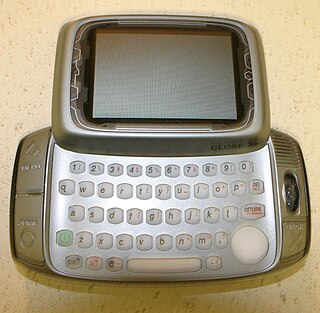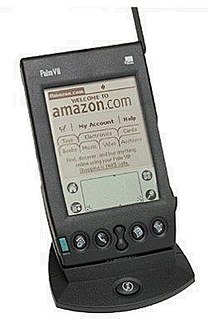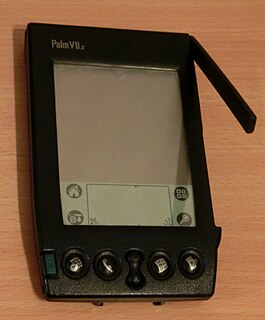Related Research Articles
Cellular Digital Packet Data (CDPD) was a wide-area mobile data service which used unused bandwidth normally used by AMPS mobile phones between 800 and 900 MHz to transfer data. Speeds up to 19.2 kbit/s were possible. The service was discontinued in conjunction with the retirement of the parent AMPS service; it has been functionally replaced by faster services such as 1xRTT, EV-DO, and UMTS/HSPA.

A personal digital assistant (PDA), also known as a handheld PC, is a variety mobile device which functions as a personal information manager. PDAs have been mostly displaced by the widespread adoption of highly capable smartphones, in particular those based on iOS and Android.

Palm OS is a discontinued mobile operating system initially developed by Palm, Inc., for personal digital assistants (PDAs) in 1996. Palm OS was designed for ease of use with a touchscreen-based graphical user interface. It is provided with a suite of basic applications for personal information management. Later versions of the OS have been extended to support smartphones. Several other licensees have manufactured devices powered by Palm OS.

The Danger Hiptop, also re-branded as the T-Mobile Sidekick, Mobiflip and Sharp Jump is a GPRS/EDGE/UMTS smartphone that was produced by Danger, Inc. from 2002 to 2010.
Mobitex is an OSI based open standard, national public access wireless packet-switched data network. Mobitex puts great emphasis on safety and reliability with its use by military, police, firefighters and ambulance services. It was developed in the beginning of the 1980s by the Swedish Televerket Radio. From 1988 the development took place in Eritel, a joint-venture between Ericsson and Televerket, later on as an Ericsson subsidiary. Mobitex became operational in Sweden in 1986.

A mobile browser is a web browser designed for use on a mobile device such as a mobile phone or PDA. Mobile browsers are optimized so as to display Web content most effectively for small screens on portable devices. Mobile browser software must be small and efficient to accommodate the low memory capacity and low-bandwidth of wireless handheld devices. Typically, they were stripped-down web browsers, however, some recent mobile browsers can handle latest technologies also such as CSS 3, JavaScript, and Ajax.

In computing, a client is a piece of computer hardware or software that accesses a service made available by a server as part of the client–server model of computer networks. The server is often on another computer system, in which case the client accesses the service by way of a network.

The Tungsten series was Palm, Inc.'s line of business-class Palm OS-based PDAs.
The Palm i705 was an upgrade from the last series of Palm PDAs to use the now discontinued Palm.net service to access the World Wide Web from Palm devices. It featured 8MB of onboard memory and SD/MMC slots. It used the Motorola Dragonball VZ 33 MHz processor and ran Palm OS 4.1, it was noted as being the first Palm.net capable device without a flip out antenna and with an internal rechargeable battery, though only the third of the three models manufactured by Palm.

A computer network is a set of computers sharing resources located on or provided by network nodes. The computers use common communication protocols over digital interconnections to communicate with each other. These interconnections are made up of telecommunication network technologies, based on physically wired, optical, and wireless radio-frequency methods that may be arranged in a variety of network topologies.

The Palm VII was a personal digital assistant made by the Palm Computing division of 3Com. The device featured an antenna used for wireless data communication, a first for a Palm device. Connectivity was provided through the Mobitex network, under the now defunct Palm.net service. Web Clipping applications, also known as Palm Query Applications (PQAs) made use of the network to request and post web data. The devices also provided PQA developers with the user's position, in the form of a zipcode, making the Palm VII the first web-enabled Location-Based Services mobile platform. The cost of service was $14.95 per month, and allowed a limited number of web pages to be viewed.
A wide variety of different wireless data technologies exist, some in direct competition with one another, others designed for specific applications. Wireless technologies can be evaluated by a variety of different metrics of which some are described in this entry.
Mobile local search is a technology that lets people search for local things using mobile equipment such as mobile phones, PDAs, and other mobile devices. Mobile local search satisfies the need to offer a mobile subscriber spontaneous access to near-position services and information such as businesses, products, events, restaurant, movie theatre or other local information. Mobile local search is the search and discovery of persons, places, and things within an identifiable space defined by distinct parameters. These parameters are evolving. Today they include social networks, individuals, cities, neighborhoods, landmarks, and actions that are relevant to the searcher's past, current, and future location. These parameters provide structure to vertically deep and horizontally broad data categories that can stand-alone or are combined to comprise searchable directories.
Wireless Application Protocol (WAP) is a technical standard for accessing information over a mobile wireless network. A WAP browser is a web browser for mobile devices such as mobile phones that use the protocol. Introduced in 1999, WAP achieved some popularity in the early 2000s, but by the 2010s it had been largely superseded by more modern standards. Almost all modern handset internet browsers now fully support HTML, so they do not need to use WAP markup for web page compatibility, and therefore, most are no longer able to render and display pages written in WML, WAP's markup language.
Windows Rally is a set of technologies from Microsoft intended to simplify the setup and maintenance of wired and wireless network-connected devices. They aim to increase reliability and security of connectivity for users who connect the devices to the Internet or to computers running Microsoft Windows. These technologies provide control of network quality of service (QoS) and diagnostics for data sharing, communications, and entertainment. Windows Rally technologies provide provisioning for the following devices:

The BlackBerry Storm is a touchscreen smartphone developed by Research In Motion. A part of the BlackBerry 9500 series of phones, it was RIM's first touchscreen device, and its first without a physical keyboard. It featured a touchscreen that responded like a button via SurePress, Research In Motion haptic feedback technology. Its competitors included Apple's iPhone, the Palm Pre, the T-Mobile G1 by HTC and the HTC Touch family.

The Palm Pre, styled as palm prē, is a multitasking smartphone that was designed and marketed by Palm with a multi-touch screen and a sliding keyboard. The smartphone was the first to use Palm's Linux-based mobile operating system, webOS. The Pre functions as a camera phone and a portable media player, and has location and navigation capabilities. The Pre also serves as a personal information manager, has a number of communication and collaboration applications, and has Bluetooth and Wi-Fi connectivity built-in.

The Palm VIIx was a personal digital assistant made by Palm, Inc. The device featured an antenna used for wireless data communication. Connectivity was provided through the Mobitex network under the now defunct Palm.net service. Web Clipping applications used the network to process data. The cost of service was $14.95 per month and allowed a limited number of web pages to be viewed.
Mobile technology is the technology used for cellular communication. Mobile technology has evolved rapidly over the past few years. Since the start of this millennium, a standard mobile device has gone from being no more than a simple two-way pager to being a mobile phone, GPS navigation device, an embedded web browser and instant messaging client, and a handheld gaming console. Many experts believe that the future of computer technology rests in mobile computing with wireless networking. Mobile computing by way of tablet computers is becoming more popular. Tablets are available on the 3G and 4G networks. Mobile technology has different meanings in different aspects, mainly mobile technology in information technology and mobile technology in basketball technology, mainly based on the wireless technology of wireless devices equipment information technology integration.
A mobile broadband modem is a type of modem that allows a personal computer or a router to receive Internet access via a mobile broadband connection instead of using telephone or cable television lines. A mobile Internet user can connect using a wireless modem to a wireless Internet Service Provider (ISP) to get Internet access.